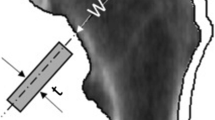Abstract
Objective
To clarify whether composite hip strength indices improve predictive ability for hip osteoporotic fractures independent of conventional bone mineral density (BMD).
Subjects and methods
Three hundred and eighty-two health controls and 43 women with hip fractures (aged 28.2–87.7 years, mean age 59.5±9.2 years) were measured by dual energy X-ray absorptiometry for femoral neck bone mineral density (FN_BMD) and proximal femur geometry parameters of hip, and composite hip strength indices (Compression strength index, Bending strength index, and Impact strength index). The association between the studied parameters and the fractures was modelled using multiple logistic regression, including age, height, weight, and menopausal status. Fracture-predicted probability was calculated for each predictor tested. ROC curve areas (AUCs) were calculated for the fracture status, having the calculated fracture-predicted probability as a test variable. AUCs were compared by the Hanley–McNeil test.
Results
Women with hip fractures had lower FN_BMD, composite hip strength indices, and longer hip axis length than controls, and no significant difference in femoral neck width. Logistic regression showed composite hip strength indices could predict hip fractures risk. To the same extent as FN BMD, Compression Strength Index (CSI) best predicted the risk for each fracture (AUC = 0.787 ± 0.028). When CSI was added to FN_BMD, there was a small but not statistically significant increase in AUC to 0.796 ± 0.027 (P = 0.9018).
Conclusion
Composite indices of femoral neck strength may be valuable in the assessment of the biomechanics of bone fragility; however, they do not appear to add diagnostic value to the simple measurement of BMD.


Similar content being viewed by others
References
Lyles KW, Schenck AP, Colón-Emeric CS. Hip and other osteoporotic fractures increase the risk of subsequent fractures in nursing home residents. Osteoporos Int. 2008;19:1225–33.
Xia WB, He SL, Xu L, et al. Rapidly increasing rates of hip fracture in Beijing, China. J Bone Miner Res. 2011. doi:10.1002/jbmr.519.
Paschalis EP, Mendelsohn R, Boskey AL. Infrared assessment of bone quality: a review. Clin Orthop Relat Res. 2011;469:2170–8.
Li GW, Tang GY, Liu Y, Tang RB, Peng YF, Li W. MR spectroscopy and micro-CT in evaluation of osteoporosis model in rabbits: comparison with histopathology. Eur Radiol. 2012;22:923–9.
Ishii S, Cauley JA, Greendale GA, Danielson ME, Safaei NN, Karlamangla A. Ethnic differences in composite indices of femoral neck strength. Osteoporos Int. 2012;23:1381–90.
Zhang H, Hu YQ, Zhang ZL. Age trends for hip geometry in Chinese men and women and the association with femoral neck fracture. Osteoporos Int. 2011;22:2513–22.
Tuck SP, Rawlings DJ, Scane AC, et al. Femoral neck shaft angle in men with fragility fractures. J Osteoporos. 2011;2011:903726.
Gao G, Zhang ZL, Zhang H, et al. Hip axis length changes in 10,554 males and females and the association with femoral neck fracture. J Clin Densitom. 2008;11:360–6.
Karlamangla AS, Barrett-Connor E, Young J, Greendale GA. Hip fracture risk assessment using composite indices of femoral neck strength: the Rancho Bernardo study. Osteoporos Int. 2004;15:62–70.
Khalil N, Sutton-Tyrrell K, Strotmeyer ES, Greendale GA, et al. Menopausal bone changes and incident fractures in diabetic women: a cohort study. Osteoporos Int. 2011;22:1367–76.
Faulkner KG, Wacker WK, Barden HS, et al. Femur strength index predicts hip fracture independent of bone density and hip axis length. Osteoporos Int. 2006;17:593–9.
Hanley JA, McNeil BJ. A method of comparing the areas under receiver operating characteristic curves derived from the same cases. Radiology. 1983;148:839–43.
Yang L, Peel N, Clowes JA, McCloskey EV, Eastell R. Use of DXA-based structural engineering models of the proximal femur to discriminate hip fracture. J Bone Miner Res. 2009;24:33–42.
Leslie WD, Pahlavan PS, Tsang JF, Lix LM. Prediction of hip and other osteoporotic fractures from hip geometry in a large clinical cohort. Osteoporos Int. 2009;20:1767–74.
Yu N, Liu YJ, Pei Y, et al. Evaluation of compressive strength index of the femoral neck in Caucasians and chinese. Calcif Tissue Int. 2010;87:324–32.
Seeman E, Duan Y, Fong C, Edmonds J. Fracture site-specific deficits in bone size and volumetric density in men with spine or hip fractures. J Bone Miner Res. 2001;16:120–7.
Alonso CG, Curiel MD, Carranza FH, Cano RP, Peréz AD. Femoral bone mineral density, neck-shaft angle and mean femoral neck width as predictors of hip fracture in men and women. Multicenter Project for Research in Osteoporosis. Osteoporos Int. 2000;11:714–20.
Jules J, Ashley JW, Feng X. Selective targeting of RANK signaling pathways as new therapeutic strategies for osteoporosis. Expert Opin Ther Targets. 2010;14:923–34.
Dong SS, Liu XG, Chen Y, et al. Association analyses of RANKL/RANK/OPG gene polymorphisms with femoral neck compression strength index variation in Caucasians. Calcif Tissue Int. 2009;85:104–12.
Jørgensen L, Crabtree NJ, Reeve J, Jacobsen BK. Ambulatory level and asymmetrical weight bearing after stroke affects bone loss in the upper and lower part of the femoral neck differently: bone adaptation after decreased mechanical loading. Bone. 2000;27:701–7.
Nilsson M, Ohlsson C, Odén A, Mellström D, Lorentzon M. Increased physical activity is associated with enhanced development of peak bone mass in men: a five year longitudinal study. J Bone Miner Res. 2012. doi:10.1002/jbmr.1549.
Acknowledgements
This study was supported by grant from the Foundation of Shanghai education commission, China (NO. 2010JW53). The authors would like to express their great appreciation to Zi-Ming Zhou, Qing-Jiao Zhang for their assistance in the recruitment of participants and editing help and Lei Zhou for hers advisory function in the statistical analysis. We wish to thank anonymous reviewers for comments that help us to improve the quality of our manuscript.
Conflict of interest
The authors declare that they have no conflict of Interest.
Author information
Authors and Affiliations
Corresponding author
Rights and permissions
About this article
Cite this article
Li, GW., Chang, SX., Xu, Z. et al. Prediction of hip osteoporotic fractures from composite indices of femoral neck strength. Skeletal Radiol 42, 195–201 (2013). https://doi.org/10.1007/s00256-012-1473-7
Received:
Revised:
Accepted:
Published:
Issue Date:
DOI: https://doi.org/10.1007/s00256-012-1473-7



